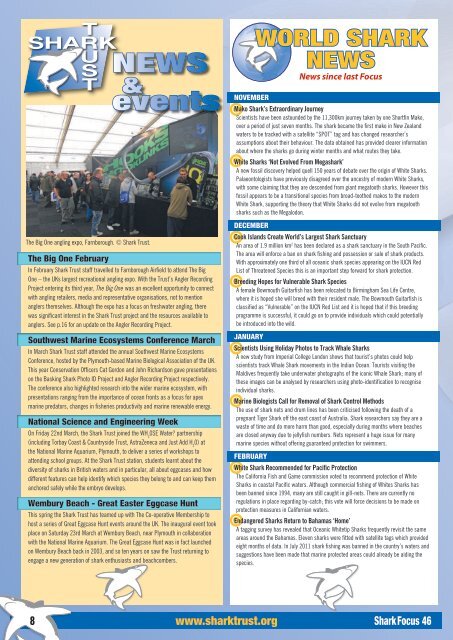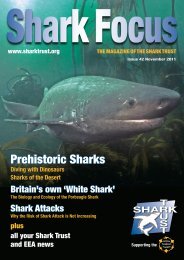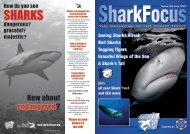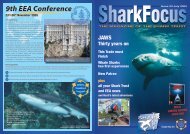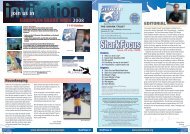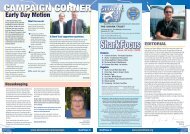Shark Focus
here - The Shark Trust
here - The Shark Trust
You also want an ePaper? Increase the reach of your titles
YUMPU automatically turns print PDFs into web optimized ePapers that Google loves.
The Big One angling expo, Farnborough. © <strong>Shark</strong> Trust.The Big One FebruaryNEWS&eventsIn February <strong>Shark</strong> Trust staff travelled to Farnborough Airfield to attend The BigOne – the UKs largest recreational angling expo. With the Trust’s Angler RecordingProject entering its third year, The Big One was an excellent opportunity to connectwith angling retailers, media and representative organisations, not to mentionanglers themselves. Although the expo has a focus on freshwater angling, therewas significant interest in the <strong>Shark</strong> Trust project and the resources available toanglers. See p.16 for an update on the Angler Recording Project.Southwest Marine Ecosystems Conference MarchIn March <strong>Shark</strong> Trust staff attended the annual Southwest Marine EcosystemsConference, hosted by the Plymouth-based Marine Biological Association of the UK.This year Conservation Officers Cat Gordon and John Richardson gave presentationson the Basking <strong>Shark</strong> Photo ID Project and Angler Recording Project respectively.The conference also highlighted research into the wider marine ecosystem, withpresentations ranging from the importance of ocean fronts as a focus for apexmarine predators, changes in fisheries productivity and marine renewable energy.National Science and Engineering WeekOn Friday 22nd March, the <strong>Shark</strong> Trust joined the WH 20SE Water? partnership(including Torbay Coast & Countryside Trust, AstraZeneca and Just Add H 20) atthe National Marine Aquarium, Plymouth, to deliver a series of workshops toattending school groups. At the <strong>Shark</strong> Trust station, students learnt about thediversity of sharks in British waters and in particular, all about eggcases and howdifferent features can help identify which species they belong to and can keep themanchored safely while the embryo develops.Wembury Beach - Great Easter Eggcase HuntThis spring the <strong>Shark</strong> Trust has teamed up with The Co-operative Membership tohost a series of Great Eggcase Hunt events around the UK. The inaugural event tookplace on Saturday 23rd March at Wembury Beach, near Plymouth in collaborationwith the National Marine Aquarium. The Great Eggcase Hunt was in fact launchedon Wembury Beach back in 2003, and so ten years on saw the Trust returning toengage a new generation of shark enthusiasts and beachcombers.WORLD SHARKNEWSNews since last <strong>Focus</strong>NovemberMako <strong>Shark</strong>’s Extraordinary JourneyScientists have been astounded by the 11,300km journey taken by one Shortfin Mako,over a period of just seven months. The shark became the first mako in New Zealandwaters to be tracked with a satellite “SPOT” tag and has changed researcher’sassumptions about their behaviour. The data obtained has provided clearer informationabout where the sharks go during winter months and what routes they take.White <strong>Shark</strong>s ‘Not Evolved From Megashark’A new fossil discovery helped quell 150 years of debate over the origin of White <strong>Shark</strong>s.Palaeontologists have previously disagreed over the ancestry of modern White <strong>Shark</strong>s,with some claiming that they are descended from giant megatooth sharks. However thisfossil appears to be a transitional species from broad-toothed makos to the modernWhite <strong>Shark</strong>, supporting the theory that White <strong>Shark</strong>s did not evolve from megatoothsharks such as the Megalodon.DecemberCook Islands Create World’s Largest <strong>Shark</strong> SanctuaryAn area of 1.9 million km 2 has been declared as a shark sanctuary in the South Pacific.The area will enforce a ban on shark fishing and possession or sale of shark products.With approximately one third of all oceanic shark species appearing on the IUCN RedList of Threatened Species this is an important step forward for shark protection.Breeding Hopes for Vulnerable <strong>Shark</strong> SpeciesA female Bowmouth Guitarfish has been relocated to Birmingham Sea Life Centre,where it is hoped she will breed with their resident male. The Bowmouth Guitarfish isclassified as “Vulnerable” on the IUCN Red List and it is hoped that if this breedingprogramme is successful, it could go on to provide individuals which could potentiallybe introduced into the wild.JanuaryScientists Using Holiday Photos to Track Whale <strong>Shark</strong>sA new study from Imperial College London shows that tourist’s photos could helpscientists track Whale <strong>Shark</strong> movements in the Indian Ocean. Tourists visiting theMaldives frequently take underwater photographs of the iconic Whale <strong>Shark</strong>; many ofthese images can be analysed by researchers using photo-identification to recogniseindividual sharks.Marine Biologists Call for Removal of <strong>Shark</strong> Control MethodsThe use of shark nets and drum lines has been criticised following the death of apregnant Tiger <strong>Shark</strong> off the east coast of Australia. <strong>Shark</strong> researchers say they are awaste of time and do more harm than good, especially during months where beachesare closed anyway due to jellyfish numbers. Nets represent a huge issue for manymarine species without offering guaranteed protection for swimmers.FebruaryWhite <strong>Shark</strong> Recommended for Pacific ProtectionThe California Fish and Game commission voted to recommend protection of White<strong>Shark</strong>s in coastal Pacific waters. Although commercial fishing of Whites <strong>Shark</strong>s hasbeen banned since 1994, many are still caught in gill-nets. There are currently noregulations in place regarding by-catch; this vote will force decisions to be made onprotection measures in Californian waters.Endangered <strong>Shark</strong>s Return to Bahamas ‘Home’A tagging survey has revealed that Oceanic Whitetip <strong>Shark</strong>s frequently revisit the sameareas around the Bahamas. Eleven sharks were fitted with satellite tags which providedeight months of data. In July 2011 shark fishing was banned in the country’s waters andsuggestions have been made that marine protected areas could already be aiding thespecies.CITES: Protecting sharks from unsustainable tradeFor the past year the <strong>Shark</strong> Trust has been working as part of theCITES4sharks coalition alongside colleagues from the German ElasmobranchSociety, Humane Society International, Project AWARE Foundation, <strong>Shark</strong>Advocates International and the Wildlife Conservation Society. As a coalitionwe have focused on supporting the listing of five species of sharks and twomanta rays on CITES Appendix II and the uplisting of Freshwater Sawfish toAppendix I.The 16th Conference of Parties to the Convention on International Trade inEndangered Species of Wild Fauna and Flora convened in Bangkok from the3rd-14th March 2013.The <strong>Shark</strong> Trust was there to contribute first-hand,and with all five shark and ray proposals adopted in Committee I, the scenewas set for what transpired to be an historic event.THE RESULTHistoric <strong>Shark</strong> Decisions Survive Final Threat at CITES PlenaryCITES4sharks on 14th March, 2013: CITES plenary accepted Committeerecommendations to list five species of highly-traded sharks under the CITESAppendices, along with those for the listing of both manta rays and one speciesof sawfish. Japan, backed by Gambia and India, unsuccessfully challenged theCommittee decision to list the Oceanic Whitetip <strong>Shark</strong>, while Grenada and Chinafailed in an attempt to reopen debate on listing three hammerhead species. Colombia,Senegal, Mexico and others took the floor to defend earlier Committee decisions tolist sharks.The Oceanic Whitetip <strong>Shark</strong>, Porbeagle, three species of hammerhead (Scalloped,Smooth and Great), and both manta rays (Giant Manta and Reef Manta) – allclassified as threatened on the IUCN Red List — will now be added to CITESAppendix II, which prompts permits to ensure exports are sustainable and legal. Theonly shark species listed under CITES prior to this CoP – Basking, Whale and White<strong>Shark</strong>s – are not taken in the high volumes associated with the newly listed sharks.The Freshwater Sawfish will be transferred from Appendix II to I, where all othersawfishes are listed, thereby completing a global ban on international commercialtrade in these Critically Endangered species.Proponents of the various listing proposals include the 27 Member States of the EU,Australia, Brazil, Colombia, Comoros, Costa Rica, Croatia, Ecuador, Egypt, Honduras,Mexico, and the USA. The shark and ray proposals received more than the two-thirdsmajority of votes necessary for adoption, while the sawfish listing succeeded byconsensusSubheadTHE ReactionText..To quote Sarah Fowler, <strong>Shark</strong> Trust Trustee and long-time advocate for increasedEmphasis text.CITES listings for sharks, as she stopped outside the plenary hall: “Super, Super,Super…”What a result! Superlatives flowed freely with press releases reflecting the‘overwhelming’ and ‘tremendous’ nature of the result – and so they should for this isone of those truly watershed moments. But this was no overnight success, insteadreflecting years of campaigning for trade controls for these high-value species.“These hard-fought decisions to secure CITES regulations on international trade insharks and rays are based on a solid foundation built over two decades, and surmountthe long-standing opposition to listing shark species that are taken on a commercialscale,” said Amie Brautigam, Marine Policy 2 Advisor for Wildlife Conservation Society.CITES TerminologyConference of Parties (CoP): There are currently 178 countries listed as Parties toCITES. All 27 EU Member States coordinate their CITES representation through theEU Presidency. The Parties meet every two to three years at the CoP which providesa fortnight of intense debate and discussion.The species proposals are considered in Committee I and, following debate andinterventions from observers, are either adopted by consensus or voted on. A twothirdsmajority is required to secure an interim adoption.The final session (likely the last two days) of the CoP is called the Plenary andthis is where all species proposals are ratified, with the opportunity for Partiesto seek an alternative outcome to that secured in Committee I. If the species isnot contentious then the Committee I decision will stand. However, if there iscontention then the debate will reopen: a brief discussion is permitted with a votethen on reopening; a one-third majority is required to reopen the debate, with twothirdsmajority then required again to finally support the proposal.Appendix I includes species threatened with extinction. Trade in these species ispermitted only in exceptional circumstances.Appendix II includes species not necessarily threatened with extinction, but inwhich trade must be controlled in order to avoid utilisation incompatible with theirsurvival.Sonja Fordham President of <strong>Shark</strong> Advocates International commented: “At the CoPin Bangkok we saw solid technical and political foundation for listing commerciallyvulnerable sharks under CITES meet with unprecedented public support for suchaction. The results of this combination made history and should secure a brighterfuture for several particularly vulnerable and highly-traded species.”ImplicationsIt is important to appreciate that listing on CITES Appendix II does not ban exports,but it can facilitate legal, sustainable trade. Permits and procedures under CITESAppendix II enable regulation of exports based on species’ status and availability.The associated documentation provides for data collection which is needed formanagement and detection of illegal trade. CITES listings do not impact on domesticfisheries for local consumption.Listing on Appendix I does, however, prohibit international trade in all bar the mostexceptional circumstance.IMPLEMENTATIONAlthough the uplisting of the Freshwater Sawfish will happen virtually overnight,CITES measures for the Appendix II species will not come into force immediately. Agrace period of 18 months has been proposed prior to implementation of the sharkand manta listings to enable Parties to establish the necessary infrastructure. NowParties face the challenge of implementation, and it will be essential that Partiessuch as the EU and the US reach out and assist less developed nations with capacitybuilding and practical implementation.For more information on the species listed visit www.sharktrust.org/cites2013.To see how the debates unfolded visit Twitter: @<strong>Shark</strong>TrustUK and@CITES4sharks8 www.sharktrust.org <strong>Shark</strong> <strong>Focus</strong> 46 <strong>Shark</strong> <strong>Focus</strong> 46 www.sharktrust.org/cites 9


